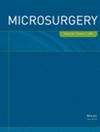Early Penile and Donor Site Sensory Outcomes After Innervated Radial Forearm Free Flap Phalloplasty: A Pilot Prospective Study
Abstract
Background
Radial forearm free flap phalloplasty (RFFF) is a set of complex reconstructive procedures aimed at creating an aesthetic and functional penis in transgender patients. Sensory recovery in the neophallus and donor site is crucial for optimizing outcomes, but the few prior studies that exist assess neophallus sensation at limited locations and time points. The purpose of this study was to prospectively quantify sensory outcomes in the neophallus and donor site following RFFF phalloplasty.
Methods
Sensation testing occurred prospectively over February 2019–January 2021 on Stage 1 RFFF phalloplasty patients using the Pressure Specified Sensory Device (PSSD). On the neophallus, one-point discrimination (1PS) pressure threshold and lengthwise sensory recovery were measured at six circumferential locations proximally to distally. On the donor site, 1PS was measured at three locations on the donor hand.
Results
Nineteen patients were included (average age 34.0 years old, range 18–53 years). Among patients that received neophallus testing (n = 13), eight had at least two follow-up appointments. Six of these patients had sensation as of their most recent measurement (75.0%), with an average of 73 days to regain sensation. There was a significantly greater proportion of patients with sensation at the right ventral (80.0% after 3 months vs. 11.1%–60.0% before 3 months, p = 0.024) and right lateral (100.0% after 3 months vs. 11.1%–60.0% before 3 months, p = 0.004) aspects of the neophallus over time. Pressure required to elicit sensation decreased by 18.0% from 1 week–1 month postoperatively to 3–7.7 months postoperatively in the right ventral neophallus (96.2 g/mm2 ± 11.3 g/mm2 to 56.6 ± 39.9 g/mm2, p = 0.037). Among patients that received donor site testing (n = 11), mixed effects regression analysis with random intercepts demonstrated significant changes in the thumb (3.4 g/mm2 ± 1.4 g/mm2, p < 0.05) and webspace (13.5 g/mm2 ± 4.9 g/mm2, p < 0.01) that returned to baseline at 3 months postoperatively (1.7 g/mm2 ± 1.0 g/mm2, p > 0.05, and 2.3 g/mm2 ± 4.0 g/mm2, p > 0.05, respectively).
Conclusion
This pilot study demonstrates that quantitative sensory testing can be used to monitor post-phalloplasty sensory changes. Recovery was significantly associated with contralateral (i.e, right side in a left forearm RFF) aspects of the neophallus, suggesting a possible pattern of circumferential sensory innervation via RFFF sensory nerves. Future studies with a larger sample size and longer follow-ups are necessary to fully characterize sensory recovery in phalloplasty patients.

 求助内容:
求助内容: 应助结果提醒方式:
应助结果提醒方式:


